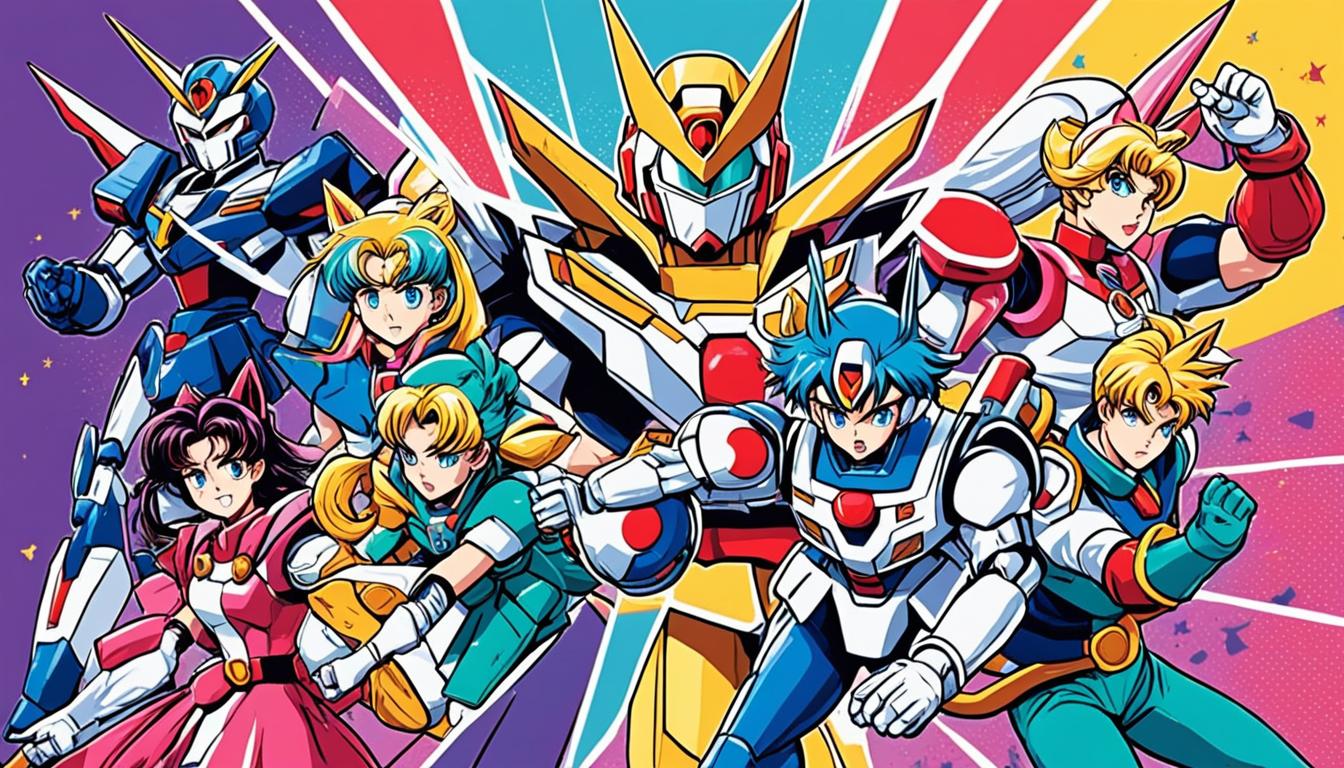The term “otaku” made it into the Oxford English Dictionary in 2007. This intriguing word comes from Japan, and it means a person deeply into hobbies. Such hobbies could be anime, manga, or even video games. Over time, otaku culture blossomed from being a small scene in Japan to a worldwide trend. This trend started after the Second World War and grew, impacting fields like music, art, and design.
As we look at how otaku culture began, where it is now, and its future, we see a world bursting with passion and creativity. Dive in, and you’ll find a community that’s always changing, bringing fresh ideas and dreams to life.
Key Takeaways:
- The word “otaku” gained attention among American anime fans through releases like Gunbuster in 1990 and Otaku no Video in 1993.
- Otaku no Video, released in 1993, is considered the “otaku bible” in the U.S. and remains a cult classic.
- The otaku subculture is said to pass through three stages: the first wave born in the early 60s, the second born around 1970, and the third born around 1980.
- Postwar Japanese culture was obsessed with Japanese-ness because of a lack of continuity.
- Otaku culture has influenced popular culture globally, with artists, musicians, and creators incorporating otaku influences into their work.
The Origins of Otaku Culture
After World War II, Japan saw big changes. The entertainment world helped shape the new Japan. Manga, anime, and video games became super popular. They let young people escape into their own worlds.
In the 1980s and 90s, “otaku” was a bad word for anime/manga fans. People thought “otaku” meant being bad at social stuff or not caring about life. But fans took it and turned it into something to be proud of. It shows their love for Japanese entertainment.
The word “otaku” first came up in the U.S. in 1990. That’s when Japanese pop culture started to grow outside Japan. “Otaku no Video,” released in the U.S. in 1993, made a big difference. It made American fans more aware of otaku culture.
In 2008, Toshio Okada wrote a book called “Otaku are Dead.” He didn’t like how cute anime was becoming mainstream. He said it changed the real otaku culture too much.
The Nomura Research Institute found 12 types of otaku. This shows how many kinds of hobbies are part of otaku culture. From manga to video games, there’s a lot to love.
When “Spirited Away” won an Oscar in 2003, it was big for Japanese animation. The movie showed off Japan’s creative talent. It made more people around the world appreciate otaku culture.
The Reappropriation of the Term
“Otaku” first showed up in a 1983 magazine essay. Then, in 1989, some otaku wrote about the term’s positive side in a book. They wanted to change its bad image. Their book helped otaku feel more united and proud.
Akihabara is known as the heart of otaku culture. It’s a special place in Tokyo. It’s full of shops selling manga, anime, and more. People who love otaku culture come from all over to visit Akihabara.
Former Prime Minister Taro Aso proudly calls himself an otaku. This helps make otaku culture more accepted. Aso showing his love for otaku things changed how many people see otaku culture.
People used to see otaku culture in a bad way. But, now, more people are celebrating it in books and online. This has helped otaku fans connect more and share their love for their hobbies.
Postwar Japan gave birth to otaku culture. It started as a way for people to find joy and connect. From bad words to a proud label, otaku culture has grown. It is now loved around the world for its creativity and passion.
The Multi-Faceted Nature of Otaku Culture
Otaku culture is much more than just anime and manga. It includes a vast array of interests and passions. This makes it very multi-faceted. The community consists of people who love Japanese visual and digital culture, but it’s much broader too.
People in this community love everything from music and fashion to cars and bird-watching. They are very dedicated and passionate. Their shared love for their hobbies brings them together. This creates a strong and supportive community.
The otaku community is diverse, including people of all genders. It’s not just for one kind of person. Everyone who loves their hobbies is welcome. This inclusivity and diversity enrich otaku culture.
What’s more, otaku culture has changed over time, reflecting what its fans care about. Media portrayals have also shifted from showing loners to more positive images. This shows a better understanding of how otaku culture can be good for people.
“Otaku have also become lynchpins for debates on anti-social behaviors, alienation, and isolation.”
Otaku culture is expanding beyond its old limits. It’s shaping not just entertainment, but also technology. Anime is a big part of this. It influences how otaku culture is seen and understood.
One key connection between otaku culture and art is the “superflat” style. This style, highlighted by Takashi Murakami, was influenced by otaku culture. It shows how closely linked otaku culture is with art today.
“Hapanese animation, or ‘anime’ as it is commonly known worldwide, is paramount for otaku culture as a defining technology.”
Artists like Takashi Murakami have helped otaku culture expand. They’ve worked with big brands, spreading otaku culture further. This includes artists like Aaron McGruder, KAWS, and Jeron Braxton.
Otaku culture has a big worldwide impact. Collaborations between Japanese and Western artists, inspired by anime, are a good example. They show how otaku culture appeals to people everywhere.
To see the wide range of interests in otaku culture, look at this table:
| Interest | Hobbies | Examples |
|---|---|---|
| Music | Music production, DJing, attending concerts | Pharrell Williams collaborating with Hatsune Miku |
| Fashion | Cosplay, streetwear, fashion design | Collaborations between Supreme and Takashi Murakami |
| Technology | Gaming, programming, virtual reality | Virtual reality gaming experiences inspired by anime |
| Art | Illustration, digital art, fan art | KAWS collaborating with Japanese toy subcultures |
This table shows how wide otaku culture is. It includes everything from music making to fashion designing. Otaku fans are very creative and passionate about their interests.
Otaku culture’s many aspects make it lively and varied. It can’t be simply defined. It grows and changes over time. By celebrating its diversity, we make a welcoming community. One that’s full of creativity and shared excitement.
Otaku Culture in Japan
Otaku culture greatly influences Japan, affecting many cultural areas. Takashi Murakami, a Japanese artist, has played a key role in making otaku culture known. He’s famous for his unique style.
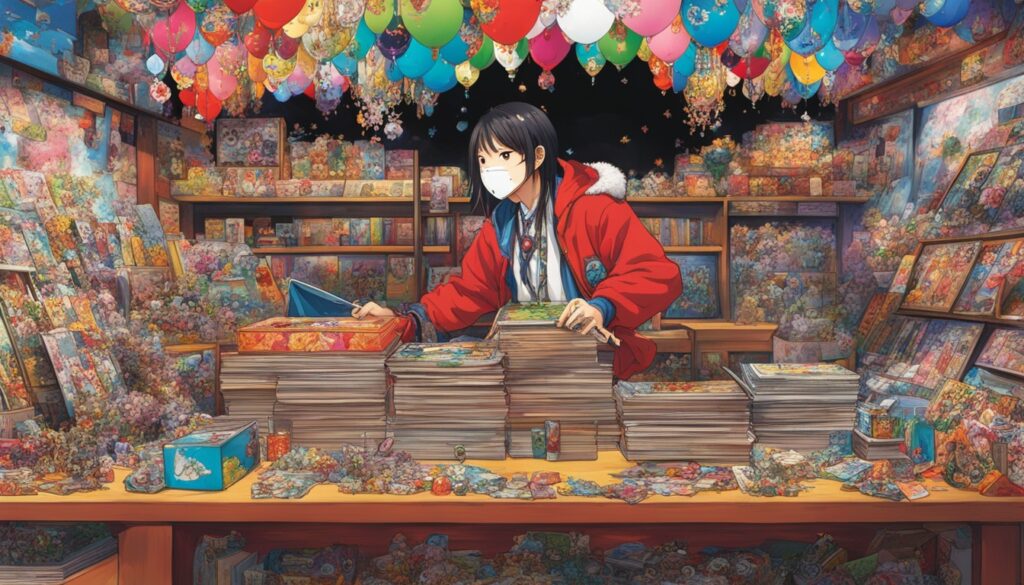
Murakami’s art uses a “superflat” style, with flat colors and images from anime and manga. This reflects his take on postwar Japanese life and otaku culture. His work is visually captivating.
More than just art, Murakami has connected otaku culture with popular brands like Louis Vuitton. This has made otaku culture more mainstream in Japan.
| Aspect of Otaku Culture | Examples |
|---|---|
| Manga | Takashi Murakami’s work often shows manga themes. |
| Anime | He uses the colorful style of anime in his art. |
| Gaming | Video games inspire his artwork. |
| Fashion | His work with fashion brands has increased otaku fashion’s popularity. |
Murakami has changed how otaku culture is seen in Japan. His work and partnerships have brought otaku influences into the mainstream. This challenges the old negative views of otaku culture in Japan.
Even though some people still look down on it, otaku culture’s popularity has grown worldwide. This began in the 90s and 2000s, helped by manga, anime, and games. Notable events, like Miyazaki’s Oscar win, have helped make otaku culture more accepted.
Today, there are many ways to celebrate otaku culture, such as through books and blogs. Patrick Galbraith’s Otaku Spaces offers a glimpse into otaku fans’ lives. Such outlets help spread understanding and respect for otaku culture in Japan.
The Akihabara district in Tokyo is a center for otaku culture. It’s known for its lively scene and many shops selling anime and manga stuff. This area breaks the stereotype of otaku and shows their diverse interests and creativity.
To sum up, Murakami and the growing acceptance of otaku culture are changing Japan’s culture. From being misunderstood to being valued, otaku culture is a key part of Japan today. Its impact is felt in art and across pop culture, making Japanese culture more widely appreciated.
Global Influence of Otaku Culture
Otaku culture has had a big impact on pop culture around the world. Many artists use anime and cultural stuff in their work. This shows how otaku culture has spread.
For example, Aaron McGruder mixes anime stuff into his show, “The Boondocks.” This makes his work special and interesting.
KAWS, from New Jersey, also uses otaku culture in his art. He’s really famous now for his unique style inspired by anime.
Jeron Braxton is another artist making waves with his 3D animations. He uses otaku themes to talk about being Black in America. He’s even used a popular game to make his art.
These artists show that otaku culture is not just about anime and manga. It’s also influencing art and pop culture everywhere. People all over the world enjoy and understand this kind of art.
The Cultural Impact of Anime References
“Anime references connect artists with a wide audience. They celebrate the creative and rich world of otaku culture.”
Art using anime references creates a language that fans and artists can both enjoy. It links them to a deep cultural history.
“Akira” is a great example. It has inspired many, from musicians like Pharrell to fashion brands. Its unique style has left a mark on culture worldwide.
Music, like hip-hop, has also embraced otaku themes. RZA mixed martial arts into his albums, influencing his music. This shows how deep otaku culture’s influence goes.
Pharrell also made a song with a virtual pop star, Hatsune Miku. This mix of cultures and creativity is a key aspect of otaku culture.
Then there’s Tyler, the Creator, who sampled a Japanese artist in his music. This collaboration shows how otaku culture bridges cultures and inspires new art.
The Fusion of Cultures: An Artistic Melting Pot
Otaku culture brings different artists together in unique ways. It sparks new projects that break boundaries and form global connections.
Art, as a result, transcends borders and cultures. It’s a way for people to understand and appreciate different parts of the world.
Artists like Aaron McGruder and Takashi Murakami are great examples. They show how otaku culture is a global thing, inspiring new ways of creating art.
Otaku culture keeps evolving and finding new fans worldwide. It’s an exciting time for artists and creators, exploring how art, culture, and tech can mix.
Otaku Cultural Influences in the Global Art Scene
| Artist | Artistic Contribution |
|---|---|
| Aaron McGruder | Incorporating anime references and visual aesthetics into “The Boondocks” |
| KAWS | Gaining global recognition through collaborations with Japanese toy and figure collecting subcultures |
| Jeron Braxton | Exploring the Black American experience using otaku influences and surreal visual allusions |
| Kanye West | Becoming a notable follower and supporter of Takashi Murakami’s work |
Otaku culture’s impact on art is clear. Aaron McGruder, KAWS, and Jeron Braxton are changing popular culture with their work.
They combine anime with their own styles, creating art that speaks to everyone. This fusion is what makes their work so appealing around the world.
Otaku Culture in Music
Otaku culture has a big influence on our music, especially hip-hop. Famous hip-hop artists mix anime, manga, and Japan’s culture into their music. This blend creates a new style that fans love.
Hip-hop artists often use samples to bring otaku culture into their music. They might take sound effects or music from Japanese media like anime and video games. This makes their songs more interesting and full of cultural nods.
Artists like RZA, Ghostface Killah from Wu-Tang Clan, Frank Ocean, and Tyler the Creator are well known for adding these influences. They talk about anime and manga in their songs, on their album covers, and in their videos.
A good example is Pharrell Williams working with Hatsune Miku on “Last Night, Good Night (Re:Dialed)” in 2014. Hatsune Miku is a virtual pop star from Japan. Their collab mixes Western and Japanese music, showcasing otaku culture’s worldwide appeal.
Also, Tyler the Creator used a song from Japanese city pop artist Tatsuro Yamashita in 2019. This not only introduced Yamashita’s music to new people but also showed otaku culture’s effect on today’s hip-hop.
It’s not just hip-hop embracing otaku culture. Artists from genres like Lupe Fiasco, Childish Gambino, Lil Uzi Vert, and Nicki Minaj do too. They often use Japanese pop and otaku elements in their songs.
Using otaku culture in music makes a global connection. It links fans through different art forms like anime, manga, and music.
Here’s a table showing how otaku culture has influenced music:
| Artist | Collaboration/Influence |
|---|---|
| RZA | Sampling anime soundtracks and dialogue in Wu-Tang Clan’s music |
| Frank Ocean | Incorporating anime references in album covers and music videos |
| Tyler the Creator | Sampling Japanese city pop artist Tatsuro Yamashita |
| Pharrell Williams | Collaborating with Hatsune Miku |
| Lupe Fiasco | Referencing anime and manga in song lyrics |
By working together and sharing their love for otaku culture, music is a melting pot of cultures and creativity.
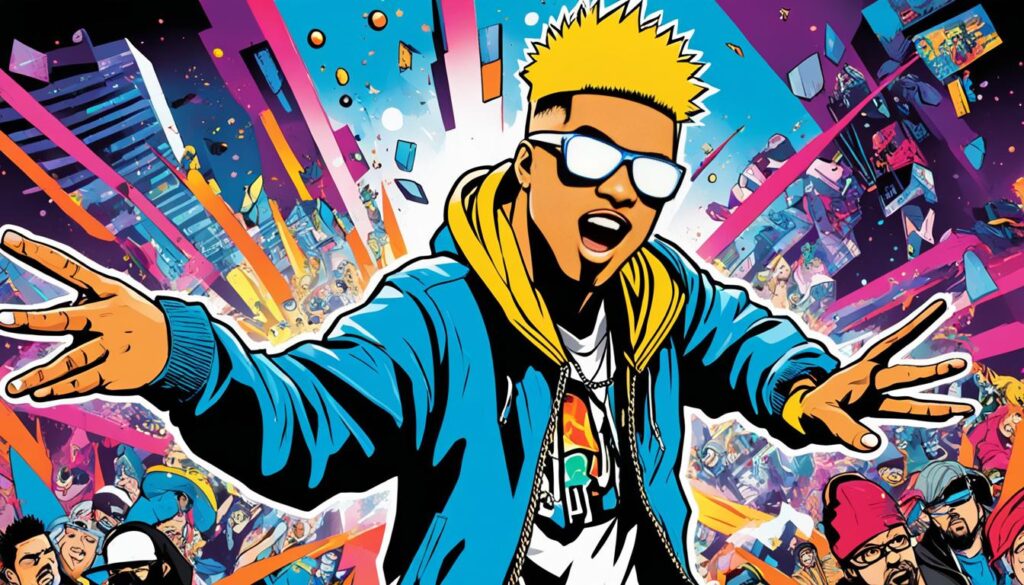
Representation of Otaku Culture in Media
Anime often shows otaku using stereotypes. Otaku are seen as shy, love 2D girls, or are fujoshi. These images can affect what people think about otaku’s roles and genders.
Stereotypes and Gender Roles
Media loves to show otaku in a certain way. Male otaku are usually awkward, maybe creepy. These ideas got really popular in the 1980s and 1990s and made things harder for male otaku.
Female otaku didn’t get much attention until the 2000s. Finally, they started being seen more in the 2000s. This helped change how people see otaku, making them question the typical male-focused view.
A Shift in Portrayals
From the late ’90s, how otaku were shown began to change. Anime like Comic Party and Genshiken showed them in a more positive light. They focused on the otaku’s passions and didn’t just show them as socially awkward.
Then came series like Doujin Work, Lucky Star, and Princess Jellyfish. They showed female otaku having various interests. This started breaking the idea that otaku culture was just for male fans.
Addressing Mental Health and Social Anxieties
In the 2000s and 2010s, anime started to talk about otaku’s mental health issues. These shows looked at otaku who struggle with social anxiety and mental health. They did so in a more serious way than before.
This gave more insight into what otaku may face. It pointed out how important addressing mental health within the community is.
Recognizing the Diversity within Otaku Culture
Otaku culture is shown in different ways in media. But, it’s just one part of a bigger, varied culture. Otaku enjoy many things besides anime and manga.
By showing the many interests of otaku, we get a better picture. We see that otaku culture is rich and inviting of all kinds of fans.
The Adoption of Otaku as a Loan Word
Loan words are frequently used across the globe. They enrich language by adding foreign terms. The process raises discussions about translation, cultural sharing, and understanding each other’s culture.
The term “otaku” comes from the Japanese language. It can mean different things to different people. Sometimes written as オタク or in hiragana as おたく. People fought over the spelling, but オタク won out, even in official documents.
The word’s history goes back to the 1980s. However, it was first written down in 1990 on the Usenet. Japanimation became popular in the United States during the 1980s and 1990s. Works like Otaku no Video became very important to American fans around 1993. A project to release a Blu-ray of Otaku no Video raised more than $100,000, showing the culture’s wide-reaching influence.
But, calling Westerners “otaku” has caused some to be upset. They think only Japanese people should use the word. This view is known as “cultural appropriation.” It shows how complex translating and understanding each other can be.
Dealing with loan words correctly helps us connect and respect each other’s cultures. We must learn the context behind these words. Promoting discussion and understanding can make our world accept and celebrate cultural differences.
Loanwords and Cultural Exchange
Language changes as cultures interact. Loan words are vital in this evolution. They bring foreign terms into our daily speech, making our languages richer.
The word “otaku” shows how Japan’s pop culture has influenced the world. It allows people from all over to share their love for anime and manga.
We must use loan words with care and understanding. Knowing where they come from can keep us from hurting or misunderstanding each other.
The Complexities of Translation
Turning words from one language into another is hard. It gets even tougher with culturally specific terms like “otaku.” We lose some of the word’s true meanings when we translate it.
The translation of “otaku” into English does not capture its full depth. Often, we have to find simpler ways to express these terms in a different language. This is to make them fit the language and culture better.
But, we must be careful to avoid misunderstandings. Talking openly about these terms can help us understand them better. It allows for a clearer view of the original idea.
Otaku Culture in the United States
The impact of otaku culture in the U.S. began with anime titles like Gunbuster and Otaku no Video. These animes showed the lives of otaku characters. They helped Americans understand and embrace the term “otaku” in the anime community.
These anime became popular in the U.S. and introduced many to otaku culture. Some fans proudly called themselves otaku and got fully into anime and manga. But, some were careful because of the negative image the term used to have.
Now, otaku culture in the U.S. is defined by how American fans see themselves in the anime scene. It includes many groups who all love anime, manga, and related hobbies.
To this day, otaku culture in America has touched many areas beyond just fun. It’s led to new trends in fashion, art, music, and tech. The passion of otaku fans has brought to life events like conventions, cosplay, and fan art. This shows the energy and commitment of the community.
“Otaku no Video played a significant role in popularizing the term ‘otaku’ among American anime fans. It served as a sort of ‘otaku bible’ for many, as it explored the lives, passions, and challenges faced by otaku individuals.”
Despite varied views, being an otaku often means sharing a deep love for anime. It’s a way to find others with similar interests, express yourself, and enjoy niche hobbies.
However, otaku culture in the U.S. is not the same for everyone. People enjoy different things, from specific genres to cosplay and collecting. This variety makes the community strong and welcoming.
As otaku culture grows in the U.S., it plays a key role in the American anime scene. It helps people discover more about themselves, connect with others, and share Japanese culture. The love for anime and manga unites fans worldwide, creating chances for cultural learning and friendship across borders.
The Meaning of Otaku in the United States
The word “otaku” has a unique meaning in the United States, within anime and manga fans. It began in Japan for anime and sci-fi lovers. But now, it includes those with a deep love for certain parts of Japanese pop culture. Being an otaku in the U.S. is more than being a fan; it shows a deep commitment and knowledge that makes them stand out.
U.S. otakus may define the term in various ways, based on their anime and manga interests. Some love collecting, Japanese video games, or dressing up in cosplay. No matter their focus, calling themselves otaku lets them connect with others who love these niche areas too. It builds a community feeling.
Identifying as an otaku shows a strong love and dedication for anime and manga. Yet, not every fan likes to call themselves that. Some find the term negative, linking it to over-the-top obsession. But for those who do, it’s a badge they wear with pride, showing off their vast knowledge and passion for the art forms.
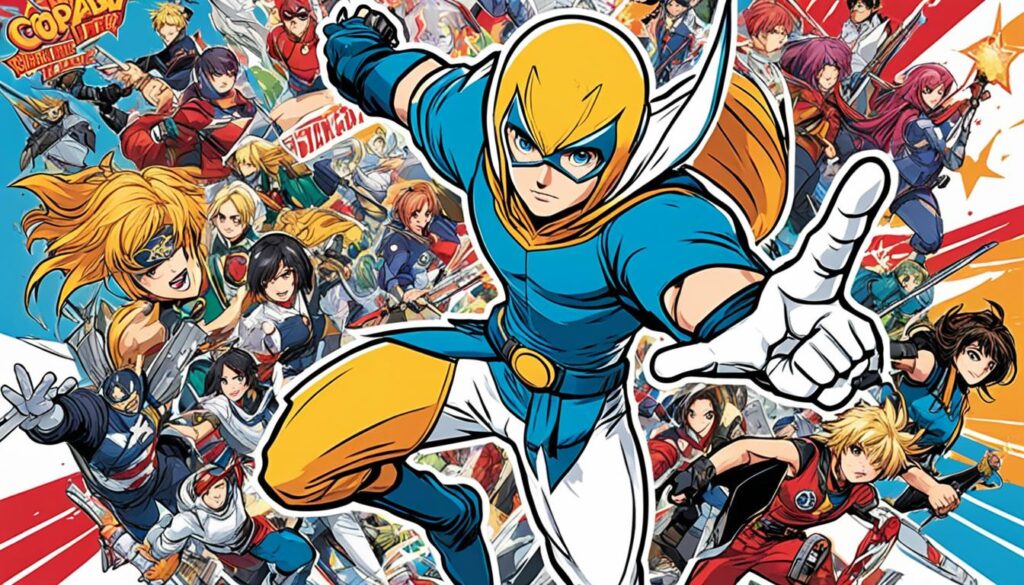
In the U.S., otaku means more than just its original Japanese definition. It now stands for a varied bunch of people deeply into anime, manga, and their cultures. Self-identifying as an otaku lets fans t show their love and connect with others. Even though meanings can vary, the term highlights the pride and expertise of being part of a fandom.
The Challenges and Misconceptions of Otaku Culture
Otaku culture faces challenges and misconceptions, both in Japan and around the world. These issues lead to a wrong view about otaku fans. The key to change this is by understanding their culture and talking openly about it.
Stigma and Stereotypes
Otaku culture is often looked down upon. Some see otaku as awkward or obsessed people. But otaku culture is not just about anime and manga. It covers a wide range of interests and should be seen for its diversity.
“Stigma and stereotypes perpetuated in media further misinterpret the true nature of otaku culture.”
Misinterpretation in Media
Media shapes how we see otaku culture. Unfortunately, it often gets it wrong, spreading false ideas. Anime and manga sometimes show otaku characters as strange, which isn’t always true. We should think critically about what we see in shows and comics.
Cultural Understanding and Education
Understanding and educating ourselves are vital to fight these wrong ideas. By talking openly and sharing correct information, we can better understand otaku culture. It’s important to see the variety of interests and talents in this community.
Learning more about otaku culture through media and cultural events can help a lot. By recognizing and supporting their efforts, we make otaku culture a part of a more welcoming world.
Challenging misconceptions needs all of us to work together. By fighting the wrong stereotypes and appreciating otaku for their creativity, we can make the cultural scene richer and more vibrant.
The Future of Otaku Culture
Otaku culture is moving into the digital age for its future growth. The online world offers chances for people to make and share their own cultural works easily. This lets otakus from around the globe come together and show their love for the culture.
Nowadays, making cultural content is easier than ever. Thanks to social media, forums, and online groups, fans can share what they love. This means you can find everything from fan art to fan stories or cosplay without much trouble. It’s putting the power of creation into the hands of the fans.
The love for otaku culture is spreading, bringing people with similar interests together. This has sparked many exciting projects where otaku culture mixes with different art forms. These efforts boost creativity and help otaku culture become more known and loved around the world.
The best part? We’re just getting started. As technology advances, so will otaku culture. Virtual reality, new media types, and interactive art are on the horizon. They promise to take the otaku experience to a whole new level.
At the core of otaku culture is community and creativity. It is important to keep this culture welcoming and positive. By celebrating new ideas and working together, otaku culture can keep growing and influencing for years to come.
| Book Details | Paperback | Ebook |
|---|---|---|
| Pages | 352 | – |
| Published | Tuesday, 28 Feb 2012 | – |
| Price | $39.00 | $35.00 |
| Illustrations | 55 black and white | – |
| ISBN | 9780300158649 | 9780300178265 |
The Impact of Otaku Culture on Popular Culture
Otaku culture began in the 1970s and 1980s in Japan. It quickly spread its influence around the world. This culture includes fans of anime, manga, gaming, and other hobbies.
It has strongly affected Japan’s manga industry. Now, manga has genres like ‘shōnen’ and ‘seinen’ for different fans. This has helped Japanese manga become very popular.
Conventions like Comiket and Anime Expo let fans meet and share their love. They take place all over the world, connecting otakus internationally. This shows how otaku culture creates a sense of togetherness.
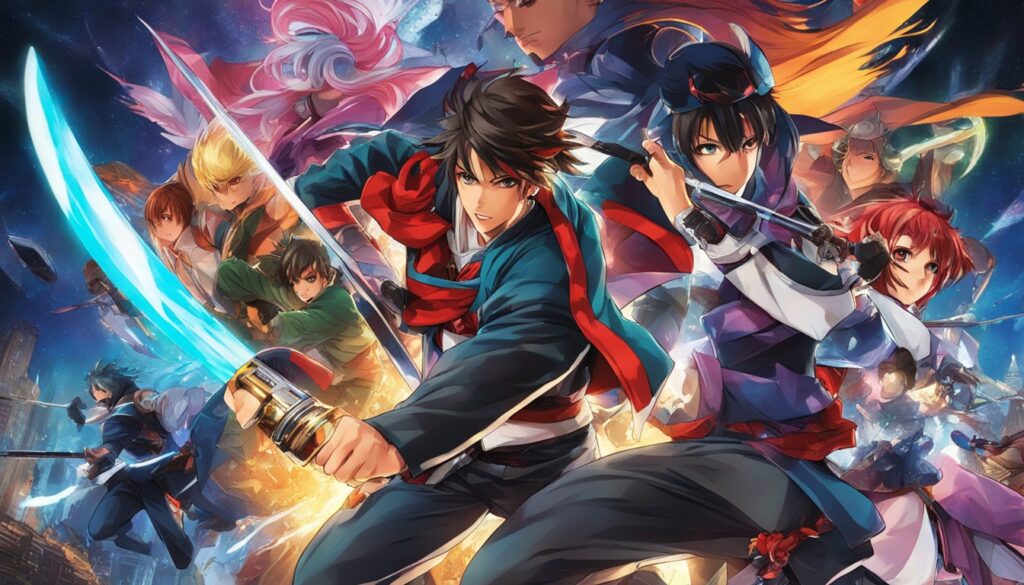
Artists such as Takashi Murakami have embraced otaku elements in their works. Thanks to otaku culture, his style has influenced fashion and art globally. This highlights how otaku culture impacts more than just entertainment.
In the broader culture, otaku trends have led to worldwide phenomena. Cosplay and fan fiction have become extremely popular. They bring new life and creativity to culture, thanks to otaku fans’ passion.
In conclusion, otaku culture has made a big mark on the world. It influences many creative areas and the entertainment world. As it keeps growing, otaku culture will surely continue to change popular culture in the future.
Cultural Exchange and Collaboration
Otaku culture has gone beyond borders, starting cultural exchanges worldwide. Artists and creators from various places are coming together because of it. This culture, rooted in Japan, has influenced artists worldwide. It has led to the creation of unique and fresh pieces.
Many exciting projects have come up by mixing otaku ideas with other art forms. Artists from Japan and the West have united for these. They show us how otaku culture can reach everyone, breaking language and cultural barriers. This has created a worldwide web of art influences.
Collaborations between the University of Texas at El Paso (UTEP) and Mexican universities show great potential in cross-cultural work. UTEP has a long partnership with Mexican schools. It has helped start many projects in fields including the environment and public health. For example, UTEP engineers and colleagues from the Instituto Tecnológico de Ciudad Juárez (ITCJ) are finding new, affordable 3D printing methods. UTEP is also working with the Universidad Autónoma de Chihuahua (UACH) to research water pollution from herbicides. These are just a few areas where they are making a difference.
Collaboration and cultural exchange are key to making new art that pushes boundaries. They bring different techniques and ideas that lead to amazing art. These efforts tell us that art is a universal language and that otaku culture connects artists globally for the love of art.
Yet, working together across cultures can be hard. Challenges like funding issues, resource differences, and red tape can be tough. The US-Mexico border is now more difficult to travel, which hinders some of this work. Still, the future is bright, with possibilities for more work together in art, literature, and social science.
For these university partnerships to succeed, we need ongoing support and funding. It’s not just about the money. Human connections between people at the universities are also vital. They help bridge gaps and keep the work going.
Embracing the Diversity of Otaku Culture
Otaku culture has really grown, capturing hearts around the world. It reflects varied interests and loves. To keep our community amazing, we must welcome everyone.
No two otaku people are exactly alike. This culture mixes many loves, like anime, manga, and more. It’s a place where people share and bond over different passions.
Understanding this mix helps us see otaku culture clearly. It’s not what the media may show. It’s about dedicated and creative people.
“Otaku culture should be a space where individuals feel accepted, respected, and celebrated for their diverse interests. It is an opportunity to bridge gaps and unite people through their shared love for Japanese popular culture.”
Celebrating Inclusivity in Otaku Culture
In otaku culture, everyone should feel like they belong. It doesn’t matter who you are; all are welcome. This makes our community stronger.
This culture keeps growing creatively. New collaborations bring fresh ideas. It lets people show who they really are through their passions.
Many find freedom in otaku culture from society’s pressures. Here, growth and friendship are found. By accepting each other, we all do better.
The Future of Inclusive Otaku Culture
The future of otaku culture is bright. It will keep changing and getting more diverse. This means new ways to be creative and more unity across the board.
Hearing different voices is key. It helps us learn from each other and grow. This will make otaku culture even better for everyone.
“As otaku culture paves the way for the future, let us celebrate the multitude of interests and talents that make the community thrive. Embracing the diversity within otaku culture ensures a positive and inclusive environment for all.”
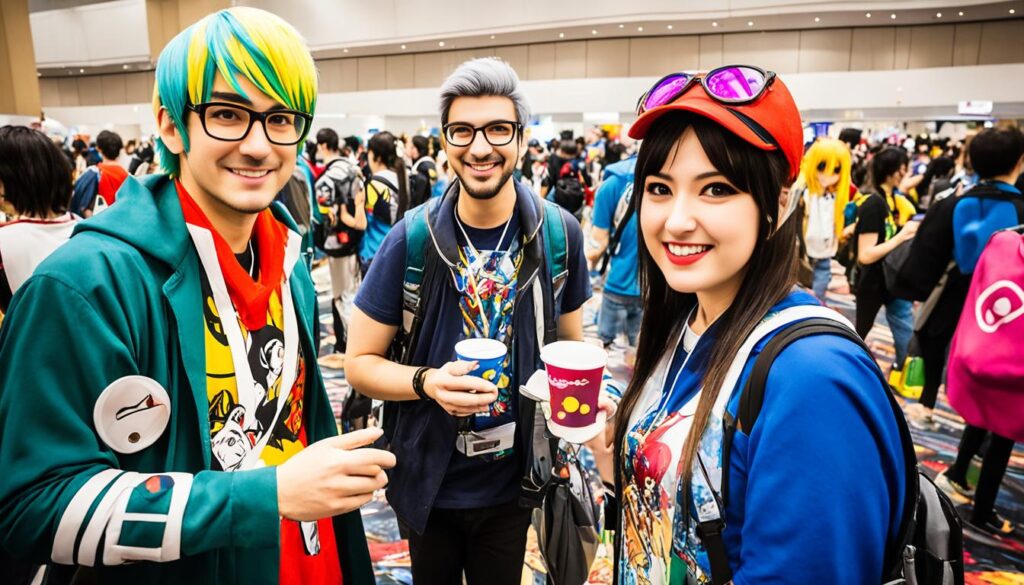
| Statistics | Source |
|---|---|
| The anime sector experienced significant growth in 2021, with a market value reaching 2,742.2 billion JPY. | Otaku Culture: The Past, Present, and Future |
| Nissan’s Ariya Lofi girl playlist campaign garnered an impressive 1.1 million hours of watch time on YouTube and resulted in a subscription increase of at least 27,000 on the company’s channel. | Otaku Culture: The Past, Present, and Future |
| Acura’s Chiaki’s Journey, an anime series to showcase its Type S vehicles, amassed close to 275 million views and effectively connected with Gen Z premium car buyers. | Otaku Culture: The Past, Present, and Future |
| Taco Bell’s Fry Force Nacho Fries campaign, targeted at millennials, evoked nostalgia and featured anime talents like actress Karen Fukahara and VTuber Gwar Gura. | Otaku Culture: The Past, Present, and Future |
| Wagamama’s anime-style ad ‘Bowl to Soul’ aimed at targeting new customers, showcasing a whimsical journey inspired by Studio Ghibli’s charm. | Otaku Culture: The Past, Present, and Future |
Conclusion
Otaku culture began in postwar Japan, starting as a small subgroup. Over time, it has grown into a large part of art, music, fashion, and media today. As we move forward, otaku culture is set to keep growing in the digital age. It will bring new trends and creative works we can enjoy.
Going from a quiet community to a global force shows otaku culture’s reach and appeal. The future looks bright, with more people worldwide getting involved. This growth is thanks to the culture’s broad interests and strong passions.
Otaku culture is now making a big impact in the creative world. It influences trends and opens doors for new projects. As different cultures mix and collaborations increase, otaku culture will play a big role in bridging these. Its importance globally in the arts and beyond is significant.
In the end, otaku culture has come a long way and has a bright future ahead. With the whole world connecting more, otaku culture will only get bigger. It leaves a lasting influence on popular culture, inspiring many for years to come.
FAQ
What is otaku culture?
Otaku culture is a subculture that started in Japan. It’s all about a deep love for things like anime, manga, video games, and idol groups.
How did otaku culture originate?
After World War II, it came from alternative visual scenes in Japan. Early on, “otaku” was used for people really into Japan’s pop culture. Now, it’s known worldwide.
What does otaku culture encompass?
Otaku culture includes a lot more than just anime and manga. It also covers music, fashion, cars, and bird-watching among other things. The key is the passion everyone shares for their hobbies.
Who is Takashi Murakami, and what role did he play in popularizing otaku culture?
Takashi Murakami is a Japanese artist famous for mixing anime and manga in his art. His work reflects postwar Japan and celebrates otaku culture. His work with big brands helped spread otaku’s influence.
How has otaku culture influenced popular culture globally?
It has left its mark on fields like art, fashion, music, and design worldwide. Artists from Aaron McGruder to KAWS have added otaku flavors to their work, showing otaku’s wide reach.
How has otaku culture influenced the music industry?
In the music world, otaku has stood out in hip-hop. Artists use sounds and music from Japan’s anime and video games in their songs. This has made a big impact on music.
How is otaku culture represented in media?
Anime and media often show otaku characters as quirky or obsessed. But, it’s important to know these are just stereotypes. Real otaku fans come in all kinds.
What is the controversy surrounding the adoption of the word “otaku” as a loan word in English?
Using “otaku” in English has sparked debate. Some say it belongs only to Japan, calling its Western use a cultural theft. It shows how complex cross-cultural words can be.
How has otaku culture been received in the United States?
In the U.S., otaku culture picked up with anime like Gunbuster and Otaku no Video. While some saw “otaku” as a good label, others were worried about the negative image it might bring.
What does the term “otaku” mean in the United States?
In the U.S., “otaku” often describes someone deeply into anime and manga. It’s more specific than “fan,” focusing on very passionate hobbyists.
What challenges and misconceptions does otaku culture face?
Misunderstandings and stereotypes still linger, both in Japan and worldwide. These often include the idea that otaku fans are socially awkward or too focused on one thing. Clearer education is needed to truly get otaku culture.
What is the future of otaku culture?
With the growth of the digital world, there are new chances for otaku culture. It will likely keep expanding and changing, drawing more people online around their common interests.
How has otaku culture impacted popular culture?
Otaku culture has deeply shaped many creative areas like art, fashion, and music. It has also inspired new forms of expression, such as cosplay and fan fiction, adding loads of variety to popular culture.
How has otaku culture facilitated cultural exchange and collaboration?
It has encouraged people from around the world, from different fields, to come together. By blending art and creativity with otaku inspiration, it’s sparked new and exciting works, showing the beauty of sharing cultures.
How can otaku culture embrace diversity?
Otaku culture should welcome everyone, no matter what they love within this broad field. This makes it a place where diverse people can meet, learn, and share, showing a rich range of interests within the community.
